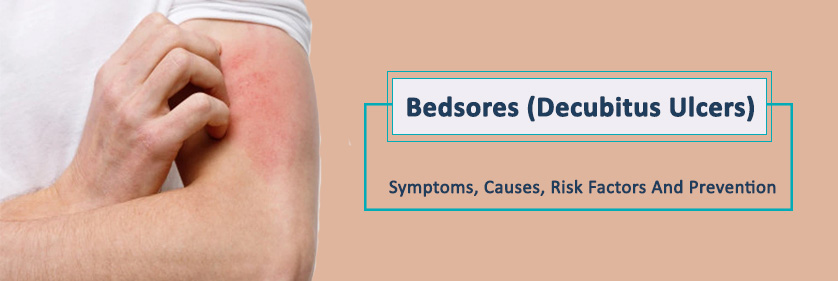What are Bedsores (Decubitus Ulcers)?
Bedsores, also known as pressure ulcers or decubitus ulcers, are damaged skin areas that can occur in people who:
- Were for long periods confined to bed
- Are unable to move for short periods, particularly if they are thin or have diseases of the blood vessels or neurological conditions
- Using a wheelchair or bedside chair (a chair that lets a patient sit upright next to the bed)
Bedsores are common in people in hospitals and nursing homes and at home care giving individuals. Bedsores shape where the person’s body weight squeezes the skin against the bed’s firm surface.
Bedsores are most common in people confined to bed over the hip, neck, lower back, tailbone, shoulder blades, elbows and heels. Bedsores appear to occur in people who use a wheelchair on the buttocks and bottoms of the feet.
This strain cuts blood flow to the skin momentarily. This causes damage to skin cells. The skin soon starts to show signs of damage until the strain is removed and blood flows back to the skin again.
The pressure triggering bedsores needn’t be very serious. Typically, as we shift regularly, including while sleeping, our skin is safe from being injured by pressure.
What are the symptoms of a decubitus ulcer?
Every level of a decubitus ulcer has different symptoms. Depending on the stage, you may have any of the following:
- Skin discoloration
- Pain in the affected area
- Infection
- Open skin
- Skin that doesn’t lighten to the touch
- Skin that’s softer or firmer than the surrounding skin
What causes bedsores?
Bedsores are injuries caused by excessive and unrelieved pressure that, due to loss of mobility and blood circulation (i.e., bedridden), damages the skin and underlying tissue. When you have to sit or lie for extended periods, the seat or bed surface places undue pressure on your body’s bony prominences or pressure points. Specific pressure points on the body include the tail bone (sacrum), parts of the hip bone, ankle and heel. Less popular locations include the knees, spine, ribs and head back.
Pressure sores may also lead from friction caused by rubbing the skin against another surface, or when two layers of skin meet on each other, travelling in opposite directions and causing damage to the tissue underlying it. This can happen while you’re being moved from a bed to a stretcher or falling in a chair.
Excessive humidity that softens the skin and decreases its resistance can also cause pressure sores. This can occur with excessive perspiration and with urinary or faecal incontinence.
Factors which are written below the place you at greater risk:
- Age over 65 years
- Immobility
- Inactivity
- Fecal or urinary incontinence
- Poor nutrition
- Decreased level of consciousness
- Low body weight
- Smoking
- Corticosteroid use
- Dry skin
- Impaired sensation
Medical conditions like as the following will may put you at risk:
- Anaemia
- Infections
- Edema
- Diabetes Mellitus
- Stroke
- Dementia
- Alcoholism
- Fractures
- Cancer Malignancies
- Peripheral Arterial Disease
- Venous Insufficiency
Risk factors
Your risk of developing bedsores is higher if you have difficulty moving and can’t change position easily while seated or in bed. Risk factors include:
- Immobility. This may be attributed to poor fitness, damage to the spinal cord and other causes.
- Incontinence. Skin becomes more vulnerable with extended exposure to urine and stool.
- Lack of sensory perception. Spinal cord injuries, neurological disorders and other conditions can result in a loss of sensation. An inability to feel pain or discomfort can result in not being aware of warning signs and the need to change position.
- Poor nutrition and hydration. Within their everyday diets, people need enough fluids, calories, carbohydrates, vitamins and minerals to maintain healthy skin and avoid tissue breakdown.
- Medical conditions which affect the flow of blood. Health problems which can affect blood flow, such as diabetes and vascular disease, can increase the risk of tissue damage such as bedsores.
What are the complications of bedsores?
Once a bedsore develops, it can take days, months, or even years to heal. It can get infected too, causing fever and chills. Infected bedsore can take a long time to clear up. It can also cause mental confusion, rapid heartbeat, and generalized weakness as the infection spreads through your body.
Prevention
Even with excellent medical and nursing care, bed sores, particularly among vulnerable patients, can be difficult to prevent.
It’s easier to avoid bedsores than to treat them, but that can be difficult too. Tips for raising the risk of developing sore on a bed include:
- Moving the patient for wheelchair users at least every 15 minutes, and every 2 hours for bed users
- Daily skin inspections
- Keeping the skin healthy and dry
- Maintaining good nutrition, to enhance overall health and wound healing
- Quitting smoking
- Exercises, even if they have to be performed in bed, will support because they improve the circulation.
Patients should notify their health care worker or doctor of any potential sores in the bed.
A physiotherapist can advise about the most suitable positions to avoid pressure sores.
Last words…
KayaWell is a platform to pair you with holistic health experts via different-2 channels. You save time and money and get well fast along with good expertise.
KayaWell offers variety of test packages with the cheapest price.
From kayaWell you can have an expert doctor in natural, integrated, systematical, functional, holistic medicine, Ayurveda, natural Gym and Yoga benefits, traditional historic medicine, acupuncture, homeopathy, and many other methods that derive their treatment and healing practices from everywhere.
For further queries, you can reach on https://www.kayawell.com/

Leave a Reply
You must be logged in to post a comment.